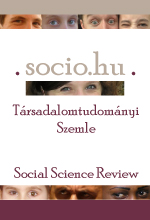Mentális térképezés a köztérkutatásban. Két környezetpszichológiai vizsgálat kutatásmódszertani tapasztalatai
Mental mapping in public space research. Methodological implications of two environmental psychology studies
Author(s): Péter Brózik, Barbara Keszei, Andrea DullSubject(s): Methodology and research technology
Published by: MTA TK Szociológiai Intézet
Keywords: environmental psychology; mental mapping; city public spaces
Summary/Abstract: According to the environmental psychology definition of the mental map, people obtain information about their environment by using it. Emotions related to city locations and the various aspects of city life play a great role in its functioning. The present paper proposes methodological considerations for using mental mapping. We reflect on issues such as what counts as qualitative data in a mental map drawing, how reliability can be ensured, how instruction influences map-drawing, what the role of spatial scale (city/district/public spaces) is, and how spatial expression on drawings can be evaluated. In two independent investigations we collected data about two public spaces in Budapest with the free recall technique. Our data sets comprised 174 drawings about Oktogon and 189 drawings about Blaha Lujza square provided by higher education students. After performing content analysis, every picture was rated by 4 independent coders. In both studies, the coding scheme we created - based on the data clearly - indicated that all kinds of city phenomena can be determining elements of mental maps: people, vehicles, even garbage. In both cases the inter-rater reliability of the cocoders was high. The drawings that could not be identified by the coders as a picture of the given square more frequently contained elements related to transportation than place-specific elements of the built environment. The impact of instruction was also obvious: the “draw a map” instruction generated significantly more maplike expressions as opposed to the “just draw” instruction. However, in the case of both instructions, map-like expressions were the most frequently produced. Comparing the data gathered from the two squares, we can say that the sources of the differences between the two squares stem not only from factual features but also from usage-based, perceived characteristics. With our methodological investigation we hope to deepen the dialogue between related disciplines.
Journal: Socio.hu Társadalomtudományi Szemle
- Issue Year: 9/2019
- Issue No: 1
- Page Range: 19-47
- Page Count: 29
- Language: Hungarian

